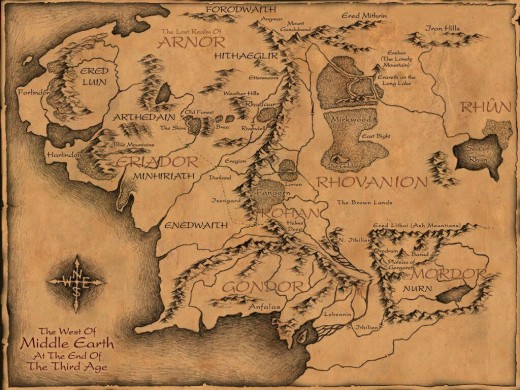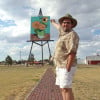Fictional Geography
Did you ever notice that fantasy novels tend to include maps of their fictional locations? It's become quite the trope now that when you crack the cover to the latest adventure novel you are bound to find some sort of line drawn map within it's pages, usually on the inside cover with clearly marked notations as to where parts of the adventure will take place. Now, I'm no expert, but I have always thought the writer's job was to tell a story, and tell it well. Surely part of that job description is to make the course of the narrative clear enough for the reader to follow WITHOUT A MAP!
And yet, there they are. From the classics going all the way back to R. L. Stevenson'sTreasure Island on...
Ever had a hankering to walk Narnia? Not from the movies, but as portrayed in the authentic book series The Chronicles Of Narnia by C.S. Lewis? Cause there's a map for that. (Pity there isn't one to help me find my way out of the back of the wardrobe.)
Of course, the 900 lb. Gorilla of fantasy novels is J.R.R. Token's The Lord Of The Rings trilogy. It's map has become the go-to design for style and substance in the mythical world, with it's stylish details of The Shire, Rivendale, The Misty Mountains, The Sea Of Rhun, The Lonely Mountain, Rohan, Gondor, Mirkwood forest, and even Mordor, which one does not simply walk into, apparently even with a map.

Stephen King avoided the issue through most of his entire magnum opus The Dark Tower, (mostly because the geography of Mid-World is finicky and changes) but finally provided a map in the seventh installment. It's inclusion may be because the reality of the tower is based so much on King's own memories of reading Tolken and being inspired to write something equally as massive, an homage to King's inspiration. Or it may be a case of jumping on the band wagon. Since then, a plethora of maps have been produced, mostly coming out of the Marvel comic book series, but since comics are a visual medium, that's a bit more acceptable.
Even George R.R. Martin and his Game Of Thrones books features a map of the realm, masterfully depicted in the animated opening of the HBO series based on the stories.
There are a few exceptions to rule, J.K. Rowling for example did not include one single map in the Harry Potter novels. No Hogwarts floor plan, no Hogshead village, no shopping map of Diagon Alley.
Now, I'm not knocking the practice, per-say. These maps are well thought out, beautifully drawn and highly imaginative. I myself used to spend hours doodling my own made up maps to lands that didn't exist anywhere but within my creative subconscious. The question is why? Why are these maps necessary? I mean, yes, when I read a book I will go and check out the map to position the player in my mind's eye. But is that just an automatic reflex just because the map is there? If there was no map would we comprehend or enjoy the story less? Is it part of the human need to categorize and label everything, even that which we know to be fake? Or does the inclusion of a map make the fictionalized world that much more real? Does it allow the fan to touch a part of the story that would otherwise be left foreign and unknown? And which is preferable?
How much is too much? When does including a map for a fictional location become less helpful to the audience and more an exercise in vanity?
For my own thoughts, I think the world should be best left to the imagination. The paint brush of my mind is quite happy to rise to the challenge of filling in those blank empty spots that simply read: "Here there be dragons"... <>








